 This week is part two of an investigation into the languages found in modern movies. These articles came from a reader’s question. Tui asked “I was wondering how many Non-U.S. English-language narrative drama features get Theatrical North American distribution“. In the end, the data took me on quite a journey, so I split what I found into two articles:
This week is part two of an investigation into the languages found in modern movies. These articles came from a reader’s question. Tui asked “I was wondering how many Non-U.S. English-language narrative drama features get Theatrical North American distribution“. In the end, the data took me on quite a journey, so I split what I found into two articles:
- Last week – What languages are most commonly used in movies?
- This week – How many non-English films get a US theatrical release?
What is a Non-English language film?
 This might sound like an obvious point, but before we can study ‘non-English language movies’, we need to be clear what we mean by that term. Many movies feature other languages whilst still having English as their primary language. For example, Wonder Woman includes snippets of German, Dutch, French, Spanish, Mandarin, Greek, and Blackfoot (a Native American Indian language), and yet I doubt that Wonder Woman is what we think of when discussing foreign language movies.
This might sound like an obvious point, but before we can study ‘non-English language movies’, we need to be clear what we mean by that term. Many movies feature other languages whilst still having English as their primary language. For example, Wonder Woman includes snippets of German, Dutch, French, Spanish, Mandarin, Greek, and Blackfoot (a Native American Indian language), and yet I doubt that Wonder Woman is what we think of when discussing foreign language movies.
Likewise, movies can be also devoid of English language dialogue save for one or two lines across the whole movie. For example, the almost-silent movie, The Artist features just ten spoken words at the very end (“Perfect. Beautiful. Could you give me one more?” and “With pleasure!“) all in English. This means that 100% of the dialogue is in English.
For today’s research, I defined a ‘Non-English language movie’ as one where English is not spoken by any of the major characters, meaning that both Wonder Woman and The Artist do not qualify.
How many movies are not in English?
This research looks at all movies released in North American cinemas for the fifteen years between 2003 and 2017 (inclusive), including re-releases and re-issues of older movies. Across these films, 1,728 non-English language movies were released, i.e. 18.8% of all movies released.
At first glance, this might appear to be high – about one in five movies which open on US cinema screens are not in English. However, it soon becomes clear why this figure doesn’t reflect our experiences in cinemas when we take a look at how those films perform. Although the movies accounted for 18.8% of releases, together they grossed just 1.1% of total domestic box office. 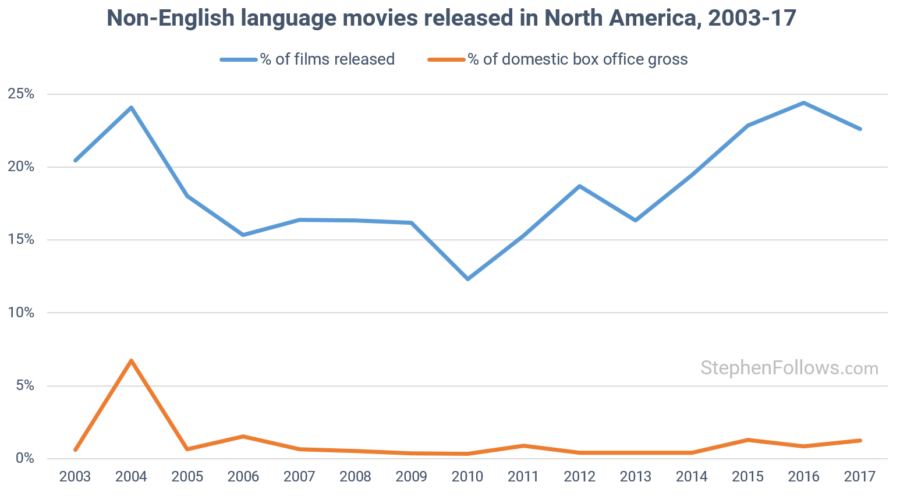 That spike you can see in 2004 is down to the most successful non-English language film of all time – The Passion of the Christ. The film grossed $370 million in North America – 22% of all the money grossed by all the non-English language movies over this fifteen year period!
That spike you can see in 2004 is down to the most successful non-English language film of all time – The Passion of the Christ. The film grossed $370 million in North America – 22% of all the money grossed by all the non-English language movies over this fifteen year period!
What genre are non-English language releases?
Non-English language films are disproportionately more likely to be dramas, with 61% of such films being a drama compared with just 50% of English language movies. Other genres which feature more non-English language movies are action, romance, musical and war. They are least likely to be documentaries, biographies and horror movies. 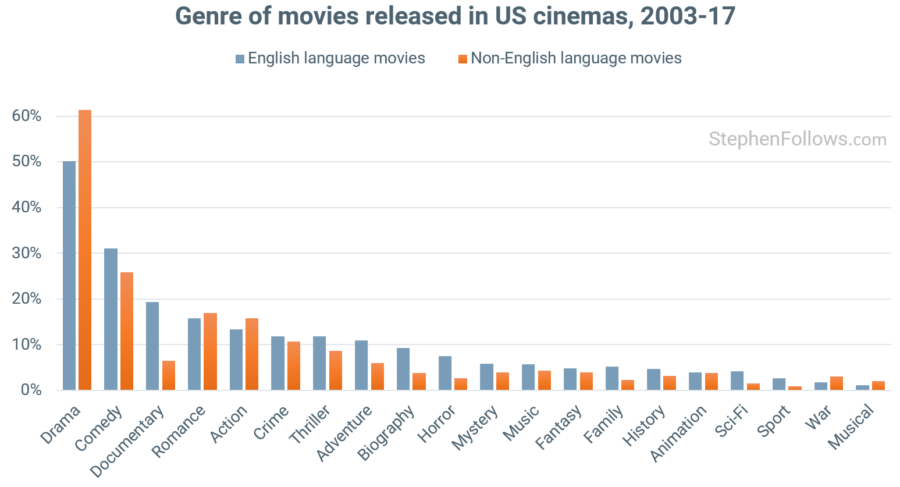
How widely are Non-English language movies released?
In a previous section, we saw that Non-English language movies collect a relatively small percentage of the total box office. This is highly correlated to the number of sites the films are released on. Let’s start by looking at how many sites English language movies played on and then compare it to non-English language movies.
For English language films, it’s a tale of two types of release – the small and the wide. 36% of English language movies played on ten or fewer sites (i.e. “the small”) whereas at the other end of the spectrum 41% of movies played on over 250 sites (i.e. “the wide”). 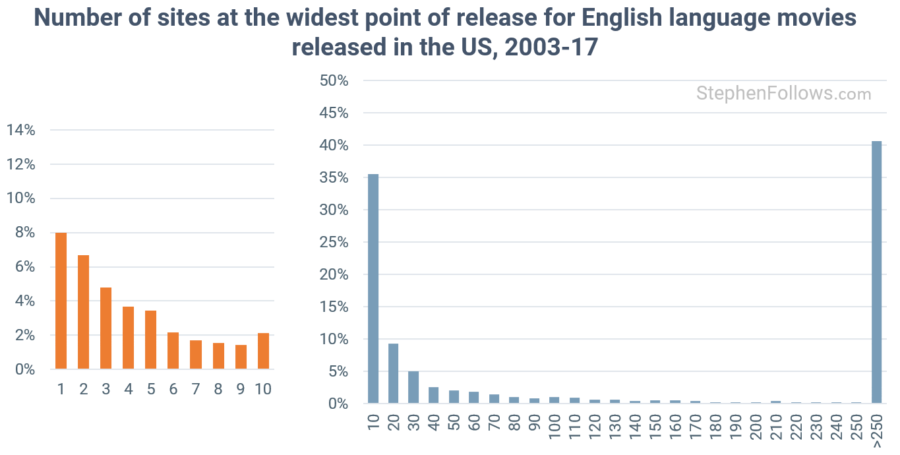 When we look at non-English language films we see a tale of just one type of release – akin to the “small” release type mentioned above. 48% of non-English language movies opened on ten or fewer sites, and only 4% opened on more than 250 sites.
When we look at non-English language films we see a tale of just one type of release – akin to the “small” release type mentioned above. 48% of non-English language movies opened on ten or fewer sites, and only 4% opened on more than 250 sites. 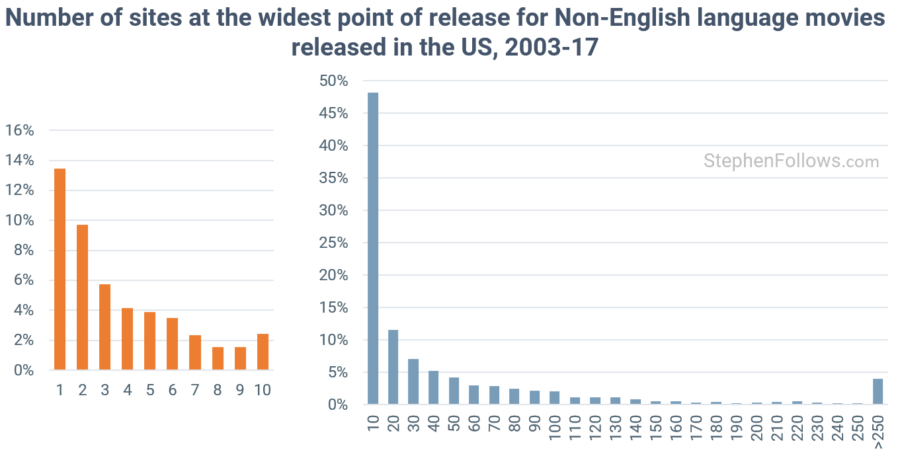 Depending on your perspective, you could say that either the movies don’t perform well so distributors don’t waste money opening them on many screens, or that their poor gross is due to the fact that audiences aren’t being given enough opportunities to watch them.
Depending on your perspective, you could say that either the movies don’t perform well so distributors don’t waste money opening them on many screens, or that their poor gross is due to the fact that audiences aren’t being given enough opportunities to watch them.
Number of weeks on release
Finally, let’s look at how long these movies stay in cinemas. By now, I expect that you will not be surprised to learn that non-English language movies leave cinemas sooner than their English language counterparts. The average English language movie stayed in cinemas for 12.3 weeks, whereas it was 10.5 for the average non-English language movie. 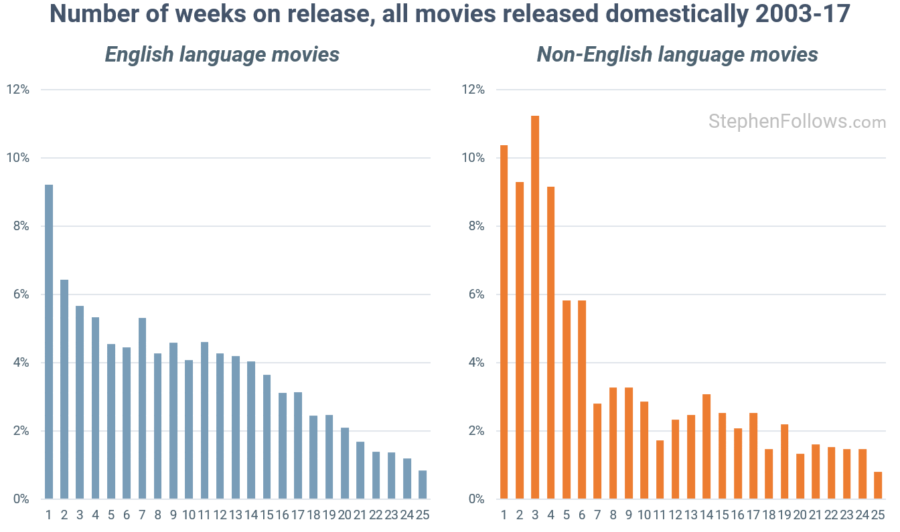
Notes
Today’s data came from IMDb, Box Office Mojo, The Numbers and Wikipedia. The study looks at feature films shown in US cinemas between 1st January 2003 and 21st December 2017 and includes re-releases and re-issues. I did not watch every movie, noting all languages spoken, so I am at the mercy of public information. I did cross reference data between sources, and in a few cases, I dug deeper individually. This may mean that some movies are missing the fact that a single character spoke a line in a non-English language. However, I do not feel this would skew the overall results.
Unless otherwise stated, all figures relate to the North American (i.e. “Domestic”) box office gross. I have not accounted for inflation in these figures. Theatrical tracking of very small releases can be patchy. This means that if a film opened on a couple of screens for just a week, then it could be missed by the organisations that gather data. Therefore, the raw numbers of movies may be slightly higher, although this kind of error is unlikely to affect the box office totals as once a movie starts to gross well, it will quickly get noticed.
I wanted to go back further than fifteen years but the further back you go the patchier the data becomes, and as non-English language films are more likely to be the smaller films (and thus most overlooked) the topic is disproportionately affected by patchy data. 2003 was the oldest year for which I could be confident I had tracked at least 99% of movies released.
I focused on spoken English, rather than written English. Therefore a movie with many English-language title cards (such as The Artist) would not trip my ‘contains English’ criteria (as discussed above, The Artist was actually excluded because of the English dialogue).
Many official listings of movies just list “Chinese”, rather than Mandarin or Cantonese. When researching the movies to discover which was used, I found that often the quickest route was to look for people complaining about the pronunciation (such as here for Wonder Woman). Sometimes, it wasn’t clear which the Chinese language was used and so I made an assumption based on the actors and the language they most commonly spoke on-screen in other movies.
I looked into this topic with regard to the UK box office three years ago. The data is slightly out of date but I believe that the trends are the same. You can read that piece here: What percentage of UK films are not in the English language?
Epilogue
Today was another example of a great question from a reader (thanks Tui!) If you have a question or query, then drop me a line. In the meantime, enjoy movie dialogue coach Erik Singer discussing fictional movie languages:


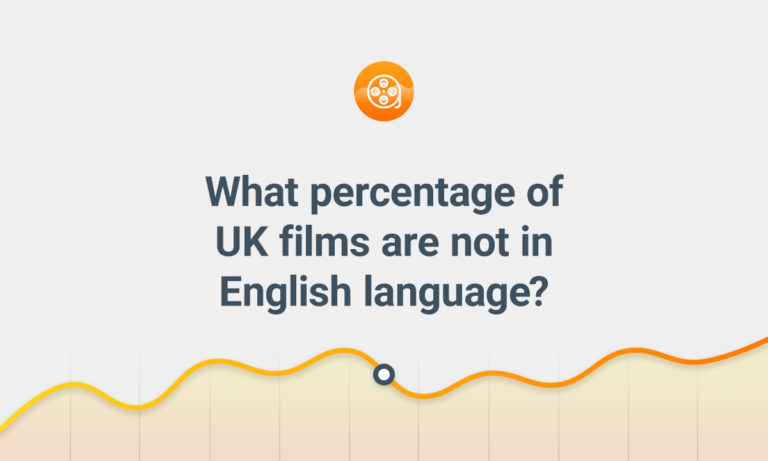


Comments
thank you Stephen
with Netflix and so many other channels now acquiring foreign language films and ted sanderos saying at Dubai film fest 2017 ‘ we don’t have / or there isn ‘t enough arabic content or content for this market to buy ‘…
it would be interesting to do the same research into the SVOD channels…
for example the current cannes v netflix argument- for ‘ non english language features a Netflix’ deal’ might be of benefit to them and to their audience who may not see these films in a cinema ..